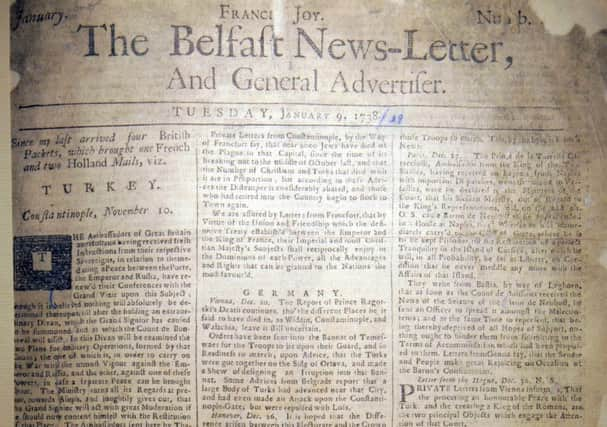Reported On This Day 280 Years Ago (Jan 20 1739): royal news; Christmas service; the coming new year


London Dec 21, 23, 26 and 28. [The dates above relate to the dates on the various letters, which then took time to reach Belfast]
(23) On Wednesday Night her Royal Highness the Princess of Wales was very much indisposed at Norfolk House, upon which his Royal Highness (not intending to reside any longer at Kew) went thither on Thursday Morning, and returned in the Afternoon and brought with him Prince and Princess Augusta. At his Return her Royal Highness was better, and last Night was so well as to be thought out of Danger of the ill Consequences that was dreaded at this Juncture. [Norfolk House in Westminster had been offered by the Duke of Norfolk to the Prince and Princess of Wales as a home after their marriage in 1736]
Advertisement
Hide AdAdvertisement
Hide AdBy Letters from Cadiz of the 9th of December, N.S. confirms the Loss of the Swedish Man of War, Capt. Wagenfeldt, bound from Caresscroon for Constantinople loaden with Arms, &c. on the West Part of that Peninsula the Day before, that the Ship was beat to Pieces, and out of 400 Men only two got ashore, one of whom presently died, they don’t mention any thing of the Patriarch, (her Consort) also loaden with Arms, therefore ‘tis hop’d she has got free from that Danger. The Insurances made on this Ship here, amounts to upwards of 20,000l. [£20,000 is around £4.5m in today’s money. The modern calendar was often used at this time, even though it did not come in until 1752. To establish which calendar was being used, the initials O.S., Old Style, and N.S., New Style, were used, as in the report above. In this case it is using the new style, unlike the newspaper itself. Thus the letter dated December 9 is also December 9 in the calendar we use today.]
(26) Yesterday being Christmas-Day the same was observed at Court as a high Festival, when the Knights Companions of the Orders of the Garter, Thistle and Bath, appear’d in the Collars of their respective Orders. At Noon his Majesty, the Duke, Princess Amelia, Caroline, and Mary, went to the Chapel Royal, preceded by the Pursuivants and Heralds at Arms, attended by a great Concourse of Nobility and Gentry, and heard a Sermon preach’d by the Rev. Dr. Gilbert, Dean of Exeter, and Sub-Almoner to his Majesty; after which, his Majesty, the Duke, &c. received the Holy Communion from the Hands of the Lord Bishop of London, Dean of the Chapel Royal, assisted by the Lord Bishop of Hereford, Clerk of the Closet to the King. His Majesty, according to Custom, made his Offering at the Altar of a Wedge of Gold, call’d the Byzant, for the Benefit of the Poor. The Sword of State was carried before his Majesty, to and from Chapel, by his Grace the Duke of Manchester, Knight of the most noble Order of the Garter.
[Christmas Day, as this Dec 26 report confirms, was celebrated on Dec 25 but that is equivalent to Jan 6 in the modern calendar]
(28) On Saturday next the Ode for the New Year, by Colley Cibber, Esq; Poet Laureat to his Majesty, and set to Musick by Dr. Maurice Greene, Master of his Majesty’s Musicl, will be rehears’d at the Golden Lyon and Devil Tavern at Temple Bar.
Advertisement
Hide AdAdvertisement
Hide Ad[This report is dated Dec 28, yet the new year was not until March, hence why the paper is in fact dated January 1738. However, as mentioned above, the new calendar was often used at this stage.
The Devil and St Dunstan was located at Fleet Street, near the Temple Bar, which was an arch that marked the western edge of the City of London. It was linked to writers over the ages from Ben Jonson in the 1500s to Dr Samuel Johnson in the 1700s. Colley Cibber, above, was an actor and playwright, born in 1671 and then in his late 60s. The tavern was demolished in the 1787]